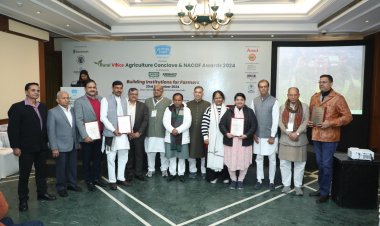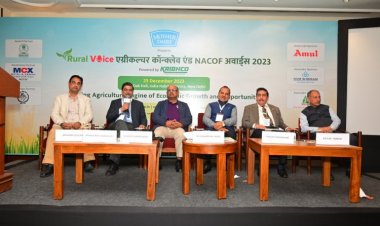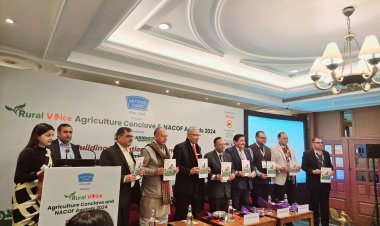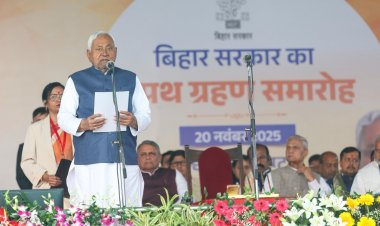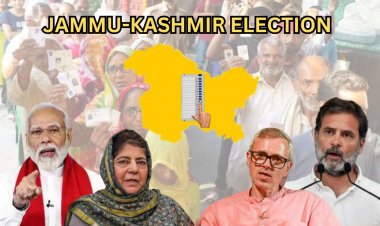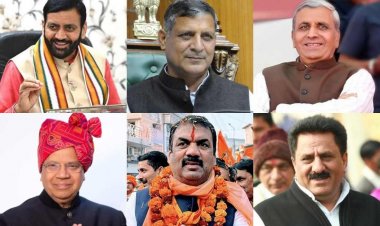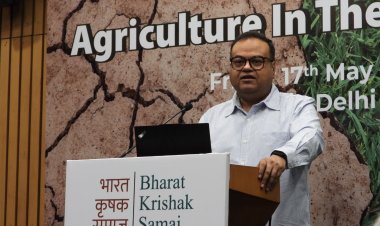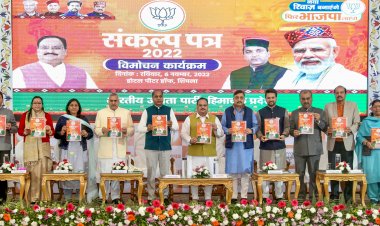Rural Voice Special: Making Agriculture India's Growth Engine
To realize the dream of a developed India, it is necessary for the villages and farmers to move forward on the path of progress.

The way to develop India's economy and take the per capita income to 12 thousand dollars will pass through farms and barns . This is not possible without a consistent annual growth rate of 4.5 percent in the agriculture sector,the largest source of employment in the country. Despite economic liberalization and unrealized intentions to raise the contribution of manufacturing in GDP, it is the agricultural sector which provides employment to 45 percent of the population. Agriculture is the backbone of the Indian economy as it is not only the largest provider of employment but also ensures the strategic food security to the country.
Going forward and on the way to realise the ambition of a developed country, a comprehensive policy and corresponding plans would be required. Ironically, such a policy does not exist at present and it is regrettable. In the year 1998, during the NDA government led by Prime Minister Atal Bihari Vajpayee, a brief document showed up in the form of agricultural policy. It could be seen as a synopsis , not as a comprehensive policy. Even this stopped right at the beginning. Thereafter, policies related to agriculture were made in bits and pieces and decisions were taken on an adhoc basis.
In the world's largest economy like America, where according to the data of 2022, there are only 20 lakh land holdings, agricultural policy is fine tuned at a certain interval. The European Union also reviews its agricultural policy at regular intervals. But no one talks about this in India. This is not an issue at all; Here the maximum focus is on marketing. The focus of the aborted agricultural laws brought in June 2020, on issues related to marketing of agricultural products.
While we have to raise agriculture growth, taking advantage of the potential available in the sector , we need to frame a policy not for the farmers but also their future generations. The policy objective should be how to retain farmers making agriculture profitable; but they are moving away from agriculture landing in cities as migration becomes unchecked. Former Director General of Indian Council of Agricultural Research (ICAR), Dr. R.S. Paroda continuously emphasizes that we have to formulate new thinking for the youth to return to agriculture and formulate and implement policies accordingly.

During the Rural Voice Agriculture Conclave organized on the third foundation day of Rural Voice last month, experts and policy makers discussed various ways to make agriculture a driver of economic development. A dialogue took place with farmer representatives. On this occasion, Dr. RS Sodhi, former MD of Amul and President of Indian Dairy Association, highlighted how the dice is always inclined in favour of consumers and not farmers in the policy makers’ priorities. Rise in Bombay Sensex is seen as a symbol of progress , but when the prices of vegetables or food items increase, it is called food inflation. In fact , this thinking and attitude needs to be changed.
Dr. Sodhi says that there will be an investment of Rs 1 lakh crore in the dairy sector alone in the next 7-8 years. If the processing of milk increases by about 12 crore liters, it will create 72 lakh new employment opportunities. By the year 2023, the food market will increase more than three times to Rs 170 lakh crore. Today consumers are ready to pay higher prices for good quality and nutritious food. Therefore, farmers should shift to the food items are in demand in the marketplace. We need to make farmers to realize immense possibilities lying untapped.
Actually,land, water, energy and labour are the foundations of agriculture. Likewise, there are four technological factors to achieve better production and productivity . These are: Genetics, Crop Nutrition, Crop Protection and Agronomic Interventions. While availability of land is important , equally important is the soil health i.e. the presence of fertile elements in it and their continuous improvement. At the same time, many experts are linking the increasing trend of contract farming in the country with deteriorating soil health.
According to Dr. Harsh Kumar Bhanwala, former Chairman of NABARD and Chairman of MCX, currently 30 percent of the farmers are those who do not own their fields. They do farming by taking land on lease or share-cropping basis. Sharecroppers who take land on short-term contracts are not serious about the health of the land because they have a short term commitment to the piece of land they are tilling. In such a situation, it is being suggested to keep the Land Lease Act as a policy priority. Such an act can give assurance to the land owner that his ownership rights will not be affected and the land can be available to the sharecropper for farming for a long time. A Model Land Lease Act has been prepared by NITI Aayog which is pending with the Ministry of Rural Development for long .
The second big factor is water. Many areas of the country have turned into dark zones due to excessive groundwater exploitation. This situation is more prevalent in areas where the Green Revolution has been successful. The solution to this can also be found at the policy level, but that is possible only through a comprehensive policy which includes assurance from crop diversification to incentives and marketing to the farmers. In view of the crisis of climate change, it is necessary to move towards crop diversification , with a practical approach.
There is continuous talk of labour. An army of unemployed youth is rising in the country but they are running away from agriculture, hence future policy provisions are necessary reverse the trend. KRIBHCO Chairman Dr. Chandrapal Singh Yadav says that today there is no attraction among the youth towards farming. This attraction will increase when farming becomes profitable. His suggestion is that the youth should join the cooperative and do farming using new technology , add value to the produce. This way, they would not only be providing employment to themselves,but also to to others. For this, the government should help in creating the infrastructure of the cooperative.
Along with this, possibilities of retaining women in agriculture sector will also have to be explored. They play a major role in the farms and allied sectors like dairy farming. . According to the latest labor force survey, most of the working population of the country works in the agricultural sector. At one time this level came down to 42 percent but due to reduction in employment opportunities in manufacturing it has reached at 45 percent again. In fact, when economic liberalization took place through the new industrial policy in 1991, there was a strong belief that industrial development in the country would accelerate and a large part of the population would leave agriculture and move to industries, due to which the burden on agriculture would reduce and rural India would become prosperous.
It is true that in the meantime urbanization has increased , but it has not been proven that a large number of people dependent on agriculture will reduce. On the other hand, the dream of making India a manufacturing hub has not been fulfilled. The government has been implementing various schemes to take manufacturing's share in Gross Domestic Product (GDP) to 25 percent and has been giving incentives worth lakhs of crores of rupees every year. But it is still stuck at 12 to 13 percent. On the other hand, after reaching about 14 percent, the share of the total number of working people is now around 11 percent according to the Labor Force Survey. The Economist estimates that an industrial growth rate of six percent would have increased employment opportunities by only one percent. The use of automation and technology in manufacturing is continuously increasing. In such a situation, if the agricultural sector grows rapidly, then more employment opportunities will be created here and it can be a more productive employment. Besides, there is huge potential for improvement in the quality of employment in the agriculture sector due to increasing use of technology.
The next factor is energy. For this, farmers are moving away from traditional farming done by oxen and have started using all modern machines including tractors. Tractors, diesel pumps and power tube wells are everywhere now. Not only this, irrigation facilities are developing rapidly using solar power. In the case of energy, farmers need certainty in its rates because increase in its cost directly means increase in the production cost for them.

As far as technology is concerned, genetics is of utmost importance in agricultural production and agricultural growth rate. Genetics decide the quality of the seed. What is the productivity and what kind of diseases and pests does it have the ability to fight? In such a situation, traditional and modern techniques available in genetics should be used to develop and refine seeds and plant material. In this, if the use of technologies like genetic modification and gene editing ensures better productivity and crop protection, then there should be no delay in adopting it. In an interview with Rural Voice, NITI Aayog member Professor Ramesh Chand has said that we should adopt GM technology in those crops where traditional technology is not successful.
Crop nutrition will have to focus on preserving the fertile elements in the soil and on the fertilizers, minerals and cropping methods necessary to increase its fertility. At the same time, it is important to go beyond selected nutrition products and use whatever products and options are available in chemical and bio-fertilizers. This will require changes in the subsidy policy for approval of new products and their affordable availability. Also, whoever provides better products in this direction in public or private sector should be given a chance. At the same time, it is important to assess the economic benefits of crop nutrition. Overnutrition should be discouraged if it does not impact productivity and economic benefits. But here the policy has to be made transparent.
After this is crop protection. The use of pesticides in crops has increased significantly in the last several decades. Besides, the rate at which crop varieties are affected by diseases has also increased. For this, it is necessary to use both chemical and bio-chemical products keeping integrated pest management at the center. But it is also true that the record of our country's companies in developing molecules in agrochemicals is very average. Most of the dependence is on molecules developed abroad and imported materials from there. Besides, a parallel industry of fake pesticides is running in the country. Due to which farmers have to suffer both financially and in the form of crop loss. The government needs to make policy changes on this issue. Also, if success is achieved in crop protection through GM varieties, then it can be taken advantage of wherever possible.
The next and important factor is agronomic intervention. Its scope is very wide. From estimating the cost of the crop to this, marketing aspects can also be added to it. The lack of research and study in our country on this front cannot be denied. If this is implemented properly then it will be beneficial for farmers and agriculture. Data on cost of production from the trial fields of research institutes should be available and there is a need for comparative study of those varieties with production, productivity and cost in farmers' fields.
It is also important to talk about the development of the agricultural sector and the possibilities of investment here. NITI Aayog member Professor Ramesh Chand says that only through an agricultural growth rate of 4.5 percent, India can fulfill the dream of being a developed nation by 2047. In such a situation, there is a better opportunity for the government to decide its economic policies keeping agriculture at the center. Although this is not happening right now, it is necessary to do so because there is huge potential in the agriculture sector which can accelerate the pace of development of the country. But for that there will have to be changes in the policies related to agriculture sector and better opportunities will have to be created for investment.
The worrying thing is that the private corporate sector has very little investment interest in the agricultural sector and that too is less than three percent. Most of the investment in agriculture sector is either public investment or farmers' own investment. This situation cannot accelerate the wheel of agricultural development. The central and state governments are giving a large part of the amount allocated for the agriculture sector in their budget in the form of income support or subsidy, while their capital expenditure is negligible. In the current year's Union Budget, the capital expenditure for agriculture is less than Rs 100 crore whereas the government has made a provision of capital expenditure of Rs 11.11 lakh crore. The largest part of this is going on the development of infrastructure facilities. Not only this, government expenditure on agricultural research and education is either stable or decreasing.
DN Thakur, national president of Sahakar Bharati, advocates the creation of a sovereign fund to overcome the capital problem of farmers. Through this fund, guarantees should be given to banks so that they can easily give loans to farmers. He says that cooperative institutions at the village level should be made so capable that their members can purchase every grain from every farmer at the minimum support price and they do not face any problem in selling their produce. In such a big country, there is a need to adopt different models of cooperative.
If all the issues highlighted above are part of an overall agricultural policy, then the economic potential of the agricultural sector can be exploited. The price and marketing structure of agricultural products is as important as production. For this, there is a need to keep the farmer's income at the center. There is a need to change the policy of domestic production, market availability, prices and import and export of crops by keeping the consumer at the centre. The most talked about issue here is that in the matter of Minimum Support Price (MSP), the thinking will have to focus on giving this price to the farmers and the perception of keeping low price at the center for the consumer will have to be changed.




 Join the RuralVoice whatsapp group
Join the RuralVoice whatsapp group

















